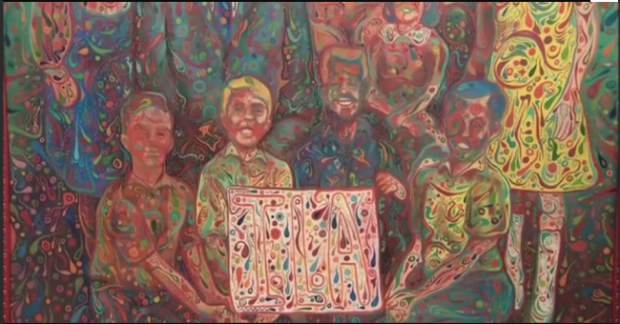Columbia University’s Rare Book and Manuscript Collection, which includes such items as an 9th (or 8th) century papyrus fragment of Homer’s “Odyssey,” Galileo’s “The Starry Messenger,” Arthur Rackham’s sketchbook for “A Midsummer Night’s Dream,” René Descartes’ “Compendium” and Tennessee Williams’ eye glasses, is also drawing the attention of scholars whose interests lie in researching the world of comics. A selection of these comics related items from the University’s collection, including a Red Sonja outfit cartoonist Wendy Pini once wore on the Mike Douglas Show in the 1970s, are currently on display at an exhibit, Comics at Columbia: Past, Present, Future, at the University’s Butler Library.
The Columbia collection was not always so robust; in 2005, when librarian for Ancient & Medieval History and Graphic Novels Karen Green initiated Butler Library’s graphic novels collection, it consisted of three books often used in curricular offerings—Art Spiegelman’s Maus, Marjane Satrapi’s Persepolis, and Joe Sacco’s Palestine. It now consists of more than 4,300 titles. Since 2011, the collection has grown to also include the life work of artists as diverse as mainstream superhero legends Jerry Robinson and Chris Claremont, Mad’s Al Jaffe, Elfquest’s Wendy and Richard Pini, and Denis Kitchen’s Kitchen Sink Press archive. In addition to original artwork, the Columbia collection contains vast amounts of letters and correspondence, contracts, editorial and business files, mechanicals, draft art and mock-ups, and other original materials for researchers that chronicle, as Green says, “the process behind the finished product.” These materials, Green adds, are proof that the comics medium “is worthy of academic study…these are the materials that bring a creator’s career into focus and provide context.”
“The year after we acquired the Claremont archives,” Green says, “that collection became the most requested collection in the entire Rare Book and Manuscript Collection…One of the things I love so much about libraries is that our core philosophy is grounded in organization, preservation and access. Not to trash talk museums, but generally a visitor sees no more than 10 percent of a museum’s collection and the rest is stored away where very few people can find it. Our Rare Book and Manuscript Library is open to a global community of scholars. Anyone conducting a research project can come and request something in the collection and it will be brought to them. This keeps the legacy of our creators alive. “



Columbia’s libraries contain more than 12 million volumes and draws four million visitors a year. Among the materials in the Columbia collection on display are:
Wendy Pini’s 1970s comic con Red Sonja costume (below), as well as her painstaking sketches of its creation–View the Youtube clip here: http://www.youtube.com/watch?v=P9wRii6aiUk

Letters between Denis Kitchen and Stan Lee about the possibility of an approved, underground version of Spider-Man (above);
The sketches and final art from Al Jaffee’s Mad/Batman fold-in alternative;
Bill Finger original script for “Punch and Judy!,” a 12-page story that appeared in Batman #31 (1940), drawn by Jerry Robinson (listed as Bob Kane);
And psychologist and Wonder Woman creator William Moulton Marston’s contract to teach at Columbia.
The exhibit also includes an ancient strip discovered in the Butler Library’s archives that dates back to the 1700s, when Columbia was know as Kings College.
“The real star of the show is a comic that was confiscated from undergraduates who had made this extremely rude comic strip making fun of a professor whom they hated in 1766, when we were still King’s College,” Green told the Columbia Spectator.
The strip, shown below, “College Intrigues, or the Amors of Patrick Pagan,” tells the tale of a student who is seduced with “spruce” beer and impregnated by a professor who then pays for her abortion. Images from the strip serve as the promotional materials for the exhibit.

Speakers at the opening included Jaffee and Claremont. In his remarks, Claremont thanked Jaffee for his help in getting his start in the industry. Jaffee was a family friend of Claremont’s parents, and when while on break from Bard College in the 1960s, Claremont asked for Jaffee’s help in securing an internship at Mad Magazine. Jaffee instead put him in touch with Stan Lee at Marvel.
“Al called Stan Lee, Stan called me, and I told Stan Lee that I would work for nothing…so I was hired,” Claremont said. “So it is my privilege that my stuff is exhibited in the same place as Al’s. You should look at his. It’s a lot more fun at mine.”
The exhibition will be on display through January 23, 2015 in Columbia’s Kempner Gallery, Rare Book & Manuscript Library (Butler Library, 6th Floor).






